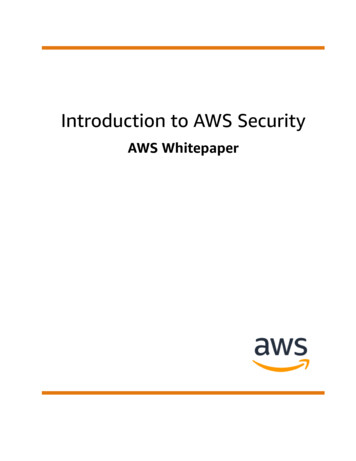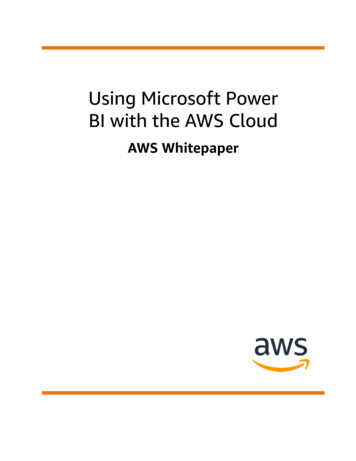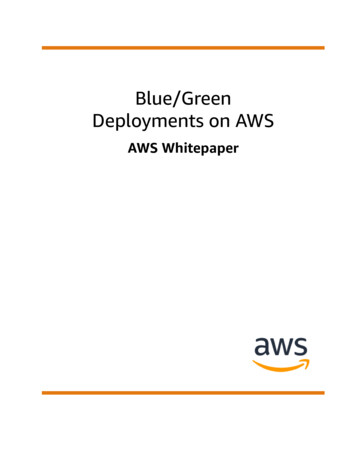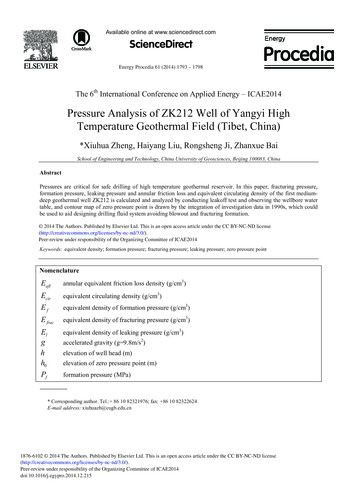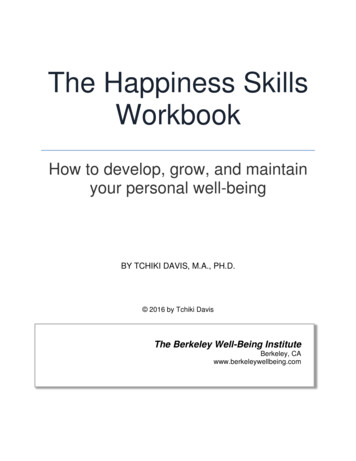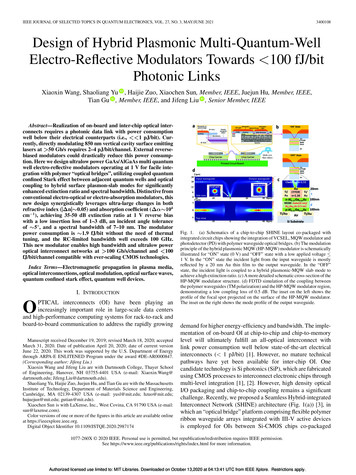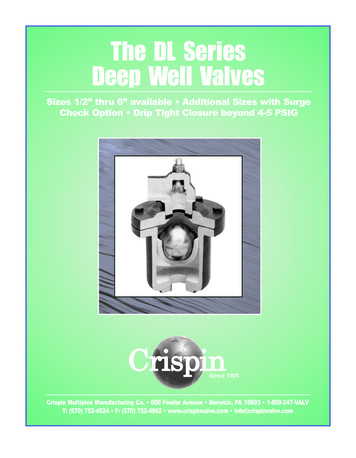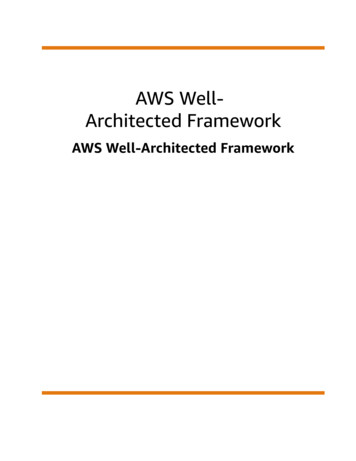
Transcription
AWS WellArchitected FrameworkAWS Well-Architected Framework
AWS Well-Architected FrameworkAWS Well-Architected FrameworkAWS Well-Architected Framework: AWS Well-Architected FrameworkCopyright Amazon Web Services, Inc. and/or its affiliates. All rights reserved.Amazon's trademarks and trade dress may not be used in connection with any product or service that is notAmazon's, in any manner that is likely to cause confusion among customers, or in any manner that disparages ordiscredits Amazon. All other trademarks not owned by Amazon are the property of their respective owners, who mayor may not be affiliated with, connected to, or sponsored by Amazon.
AWS Well-Architected FrameworkAWS Well-Architected FrameworkTable of ContentsAbstract and Introduction . 1Abstract . 1Introduction . 1Definitions . 1On Architecture . 3General Design Principles . 4The Pillars of the Framework . 5Operational Excellence . 5Design Principles . 5Definition . 6Best Practices . 6Resources . 12Security . 12Design Principles . 12Definition . 13Best Practices . 13Resources . 18Reliability . 18Design Principles . 19Definition . 19Best Practices . 19Resources . 23Performance Efficiency . 23Design Principles . 24Definition . 24Best Practices . 24Resources . 29Cost Optimization . 29Design Principles . 30Definition . 30Best Practices . 31Resources . 34Sustainability . 35Design Principles . 35Definition . 36Best Practices . 36The Review Process . 41Conclusion . 43Contributors . 44Further Reading . 45Document Revisions . 46Appendix: Questions and Best Practices . 48Operational Excellence . 48Organization . 48Prepare . 50Operate . 53Evolve . 55Security . 55Security . 56Identity and Access Management . 57Detection . 58Infrastructure Protection . 59Data Protection . 60Incident Response . 61iii
AWS Well-Architected FrameworkAWS Well-Architected FrameworkReliability .Foundations .Workload Architecture .Change Management .Failure Management .Performance Efficiency .Selection .Review .Monitoring .Tradeoffs .Cost Optimization .Practice Cloud Financial Management .Expenditure and usage awareness .Cost-effective resources .Manage demand and supply resources .Optimize over time .Sustainability .Region selection .User behavior patterns .Software and architecture patterns .Data patterns .Hardware patterns .Development and deployment process .Notices 3
AWS Well-Architected FrameworkAWS Well-Architected FrameworkAbstractAWS Well-Architected FrameworkPublication date: December 2, 2021 (Document Revisions (p. 46))AbstractThe AWS Well-Architected Framework helps you understand the pros and cons of decisions you makewhile building systems on AWS. By using the Framework you will learn architectural best practices fordesigning and operating reliable, secure, efficient, and cost-effective systems in the cloud.IntroductionThe AWS Well-Architected Framework helps you understand the pros and cons of decisions you makewhile building systems on AWS. Using the Framework helps you learn architectural best practices fordesigning and operating secure, reliable, efficient, cost-effective, and sustainable workloads in the AWSCloud. It provides a way for you to consistently measure your architectures against best practices andidentify areas for improvement. The process for reviewing an architecture is a constructive conversationabout architectural decisions, and is not an audit mechanism. We believe that having well-architectedsystems greatly increases the likelihood of business success.AWS Solutions Architects have years of experience architecting solutions across a wide varietyof business verticals and use cases. We have helped design and review thousands of customers’architectures on AWS. From this experience, we have identified best practices and core strategies forarchitecting systems in the cloud.The AWS Well-Architected Framework documents a set of foundational questions that allow you tounderstand if a specific architecture aligns well with cloud best practices. The framework provides aconsistent approach to evaluating systems against the qualities you expect from modern cloud-basedsystems, and the remediation that would be required to achieve those qualities. As AWS continues toevolve, and we continue to learn more from working with our customers, we will continue to refine thedefinition of well-architected.This framework is intended for those in technology roles, such as chief technology officers (CTOs),architects, developers, and operations team members. It describes AWS best practices and strategiesto use when designing and operating a cloud workload, and provides links to further implementationdetails and architectural patterns. For more information, see the AWS Well-Architected homepage.AWS also provides a service for reviewing your workloads at no charge. The AWS Well-ArchitectedTool (AWS WA Tool) is a service in the cloud that provides a consistent process for you to review andmeasure your architecture using the AWS Well-Architected Framework. The AWS WA Tool providesrecommendations for making your workloads more reliable, secure, efficient, and cost-effective.To help you apply best practices, we have created AWS Well-Architected Labs, which provides you witha repository of code and documentation to give you hands-on experience implementing best practices.We also have teamed up with select AWS Partner Network (APN) Partners, who are members of the AWSWell-Architected Partner program. These APN Partners have deep AWS knowledge, and can help youreview and improve your workloads.DefinitionsEvery day, experts at AWS assist customers in architecting systems to take advantage of best practicesin the cloud. We work with you on making architectural trade-offs as your designs evolve. As you deploy1
AWS Well-Architected FrameworkAWS Well-Architected FrameworkDefinitionsthese systems into live environments, we learn how well these systems perform and the consequences ofthose trade-offs.Based on what we have learned, we have created the AWS Well-Architected Framework, which providesa consistent set of best practices for customers and partners to evaluate architectures, and provides a setof questions you can use to evaluate how well an architecture is aligned to AWS best practices.The AWS Well-Architected Framework is based on six pillars — operational excellence, security, reliability,performance efficiency, cost optimization, and sustainability.Table 1. The pillars of the AWS Well-Architected FrameworkNameDescriptionOperational ExcellenceThe ability to support development and runworkloads effectively, gain insight into theiroperations, and to continuously improvesupporting processes and procedures to deliverbusiness value.SecurityThe security pillar describes how to takeadvantage of cloud technologies to protect data,systems, and assets in a way that can improveyour security posture.ReliabilityThe reliability pillar encompasses the ability ofa workload to perform its intended functioncorrectly and consistently when it’s expected to.This includes the ability to operate and test theworkload through its total lifecycle. This paperprovides in-depth, best practice guidance forimplementing reliable workloads on AWS.Performance EfficiencyThe ability to use computing resources efficientlyto meet system requirements, and to maintainthat efficiency as demand changes andtechnologies evolve.Cost OptimizationThe ability to run systems to deliver businessvalue at the lowest price point.SustainabilityThe ability to continually improve sustainabilityimpacts by reducing energy consumption andincreasing efficiency across all components of aworkload by maximizing the benefits from theprovisioned resources and minimizing the totalresources required.In the AWS Well-Architected Framework, we use these terms: A component is the code, configuration, and AWS Resources that together deliver against arequirement. A component is often the unit of technical ownership, and is decoupled from othercomponents. The term workload is used to identify a set of components that together deliver business value. Aworkload is usually the level of detail that business and technology leaders communicate about. We think about architecture as being how components work together in a workload. How componentscommunicate and interact is often the focus of architecture diagrams.2
AWS Well-Architected FrameworkAWS Well-Architected FrameworkOn Architecture Milestones mark key changes in your architecture as it evolves throughout the product lifecycle(design, implementation, testing, go live, and in production). Within an organization the technology portfolio is the collection of workloads that are required forthe business to operate.When architecting workloads, you make trade-offs between pillars based on your business context. Thesebusiness decisions can drive your engineering priorities. You might optimize to improve sustainabilityimpact and reduce cost at the expense of reliability in development environments, or, for mission-criticalsolutions, you might optimize reliability with increased costs and sustainability impact. In ecommercesolutions, performance can affect revenue and customer propensity to buy. Security and operationalexcellence are generally not traded-off against the other pillars.On ArchitectureIn on-premises environments, customers often have a central team for technology architecture that actsas an overlay to other product or feature teams to ensure they are following best practice. Technologyarchitecture teams typically include a set of roles such as: Technical Architect (infrastructure), SolutionsArchitect (software), Data Architect, Networking Architect, and Security Architect. Often these teams useTOGAF or the Zachman Framework as part of an enterprise architecture capability.At AWS, we prefer to distribute capabilities into teams rather than having a centralized team withthat capability. There are risks when you choose to distribute decision making authority, for example,ensuring that teams are meeting internal standards. We mitigate these risks in two ways. First, we havepractices (ways of doing things, process, standards, and accepted norms) that focus on enabling eachteam to have that capability, and we put in place experts who ensure that teams raise the bar on thestandards they need to meet. Second, we implement mechanisms that carry out automated checks toensure standards are being met.“Good intentions never work, you need good mechanisms to make anything happen” — JeffBezos.This means replacing humans best efforts with mechanisms (often automated) that check for compliancewith rules or process. This distributed approach is supported by the Amazon leadership principles,and establishes a culture across all roles that works back from the customer. Working backward is afundamental part of our innovation process. We start with the customer and what they want, and letthat define and guide our efforts. Customer-obsessed teams build products in response to a customerneed.For architecture, this means that we expect every team to have the capability to create architectures andto follow best practices. To help new teams gain these capabilities or existing teams to raise their bar,we enable access to a virtual community of principal engineers who can review their designs and helpthem understand what AWS best practices are. The principal engineering community works to makebest practices visible and accessible. One way they do this, for example, is through lunchtime talks thatfocus on applying best practices to real examples. These talks are recorded and can be used as part ofonboarding materials for new team members.AWS best practices emerge from our experience running thousands of systems at internet scale. Weprefer to use data to define best practice, but we also use subject matter experts, like principal engineers,to set them. As principal engineers see new best practices emerge, they work as a community toensure that teams follow them. In time, these best practices are formalized into our internal reviewprocesses, as well as into mechanisms that enforce compliance. The Well-Architected Framework is thecustomer-facing implementation of our internal review process, where we have codified our principalengineering thinking across field roles, like Solutions Architecture and internal engineering teams. TheWell-Architected Framework is a scalable mechanism that lets you take advantage of these learnings.By following the approach of a principal engineering community with distributed ownership ofarchitecture, we believe that a Well-Architected enterprise architecture can emerge that is driven by3
AWS Well-Architected FrameworkAWS Well-Architected FrameworkGeneral Design Principlescustomer need. Technology leaders (such as a CTOs or development managers), carrying out WellArchitected reviews across all your workloads will allow you to better understand the risks in yourtechnology portfolio. Using this approach, you can identify themes across teams that your organizationcould address by mechanisms, training, or lunchtime talks where your principal engineers can share theirthinking on specific areas with multiple teams.General Design PrinciplesThe Well-Architected Framework identifies a set of general design principles to facilitate good design inthe cloud: Stop guessing your capacity needs: If you make a poor capacity decision when deploying a workload,you might end up sitting on expensive idle resources or dealing with the performance implications oflimited capacity. With cloud computing, these problems can go away. You can use as much or as littlecapacity as you need, and scale up and down automatically. Test systems at production scale: In the cloud, you can create a production-scale test environment ondemand, complete your testing, and then decommission the resources. Because you only pay for thetest environment when it's running, you can simulate your live environment for a fraction of the costof testing on premises. Automate to make architectural experimentation easier: Automation allows you to create andreplicate your workloads at low cost and avoid the expense of manual effort. You can track changes toyour automation, audit the impact, and revert to previous parameters when necessary. Allow for evolutionary architectures: In a traditional environment, architectural decisions are oftenimplemented as static, onetime events, with a few major versions of a system during its lifetime.As a business and its context continue to evolve, these initial decisions might hinder the system'sability to deliver changing business requirements. In the cloud, the capability to automate and test ondemand lowers the risk of impact from design changes. This allows systems to evolve over time so thatbusinesses can take advantage of innovations as a standard practice. Drive architectures using data: In the cloud, you can collect data on how your architectural choicesaffect the behavior of your workload. This lets you make fact-based decisions on how to improveyour workload. Your cloud infrastructure is code, so you can use that data to inform your architecturechoices and improvements over time. Improve through game days: Test how your architecture and processes perform by regularlyscheduling game days to simulate events in production. This will help you understand whereimprovements can be made and can help develop organizational experience in dealing with events.4
AWS Well-Architected FrameworkAWS Well-Architected FrameworkOperational ExcellenceThe Pillars of the FrameworkCreating a software system is a lot like constructing a building. If the foundation is not solid, structuralproblems can undermine the integrity and function of the building. When architecting technologysolutions, if you neglect the six pillars of operational excellence, security, reliability, performanceefficiency, cost optimization, and sustainability, it can become challenging to build a system that deliverson your expectations and requirements. Incorporating these pillars into your architecture will help youproduce stable and efficient systems. This will allow you to focus on the other aspects of design, such asfunctional requirements.Pillars Operational Excellence (p. 5) Security (p. 12) Reliability (p. 18) Performance Efficiency (p. 23) Cost Optimization (p. 29) Sustainability (p. 35)Operational ExcellenceThe Operational Excellence pillar includes the ability to support development and run workloadseffectively, gain insight into their operations, and to continuously improve supporting processes andprocedures to deliver business value.The operational excellence pillar provides an overview of design principles, best practices, and questions.You can find prescriptive guidance on implementation in the Operational Excellence Pillar whitepaper.Topics Design Principles (p. 5) Definition (p. 6) Best Practices (p. 6) Resources (p. 12)Design PrinciplesThere are five design principles for operational excellence in the cloud: Perform operations as code: In the cloud, you can apply the same engineering discipline that you usefor application code to your entire environment. You can define your entire workload (applications,infrastructure) as code and update it with code. You can implement your operations procedures ascode and automate their execution by triggering them in response to events. By performing operationsas code, you limit human error and enable consistent responses to events. Make frequent, small, reversible changes: Design workloads to allow components to be updatedregularly. Make changes in small increments that can be reversed if they fail (without affectingcustomers when possible). Refine operations procedures frequently: As you use operations procedures, look for opportunitiesto improve them. As you evolve your workload, evolve your procedures appropriately. Set up regular5
AWS Well-Architected FrameworkAWS Well-Architected FrameworkDefinitiongame days to review and validate that all procedures are effective and that teams are familiar withthem. Anticipate failure: Perform “pre-mortem” exercises to identify potential sources of failure so thatthey can be removed or mitigated. Test your failure scenarios and validate your understanding of theirimpact. Test your response procedures to ensure that they are effective, and that teams are familiarwith their execution. Set up regular game days to test workloads and team responses to simulatedevents. Learn from all operational failures: Drive improvement through lessons learned from all operationalevents and failures. Share what is learned across teams and through the entire organization.DefinitionThere are four best practice areas for operational excellence in the cloud: Organization Prepare Operate EvolveYour organization’s leadership defines business objectives. Your organization must understandrequirements and priorities and use these to organize and conduct work to support the achievement ofbusiness outcomes. Your workload must emit the information necessary to support it. Implementingservices to enable integration, deployment, and delivery of your workload will enable an increased flowof beneficial changes into production by automating repetitive processes.There may be risks inherent in the operation of your workload. You must understand those risks andmake an informed decision to enter production. Your teams must be able to support your workload.Business and operational metrics derived from desired business outcomes will enable you to understandthe health of your workload, your operations activities, and respond to incidents. Your priorities willchange as your business needs and business environment changes. Use these as a feedback loop tocontinually drive improvement for your organization and the operation of your workload.Best PracticesTopics Organization (p. 6) Prepare (p. 9) Operate (p. 10) Evolve (p. 11)OrganizationYour teams need to have a shared understanding of your entire workload, their role in it, and sharedbusiness goals to set the priorities that will enable business success. Well-defined priorities will maximizethe benefits of your efforts. Evaluate internal and external customer needs involving key stakeholders,including business, development, and operations teams, to determine where to focus efforts. Evaluatingcustomer needs will ensure that you have a thorough understanding of the support that is requiredto achieve business outcomes. Ensure that you are aware of guidelines or obligations defined by yourorganizational governance and external factors, such as regulatory compliance requirements andindustry standards, that may mandate or emphasize specific focus. Validate that you have mechanismsto identify changes to internal governance and external compliance requirements. If no requirements6
AWS Well-Architected FrameworkAWS Well-Architected FrameworkBest Practicesare identified, ensure that you have applied due diligence to this determination. Review your prioritiesregularly so that they can be updated as needs change.Evaluate threats to the business (for example, business risk and liabilities, and informat
architecture teams typically include a set of roles such as: Technical Architect (infrastructure), Solutions Architect (software), Data Architect, Networking Architect, and Security Architect. Often

